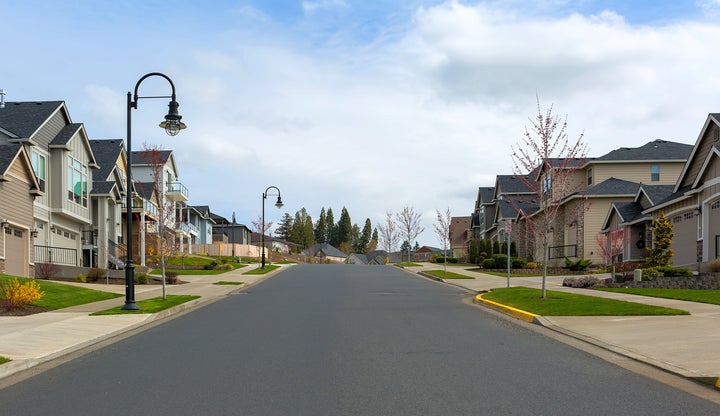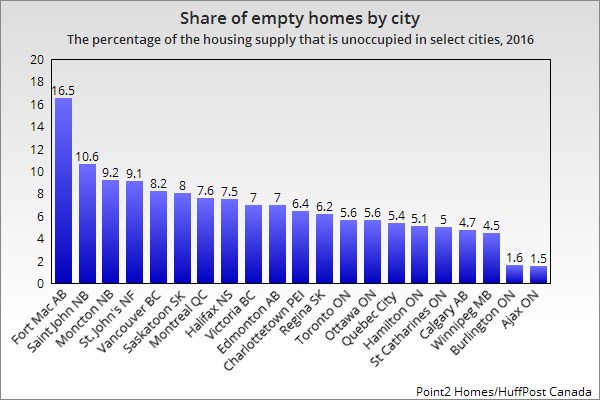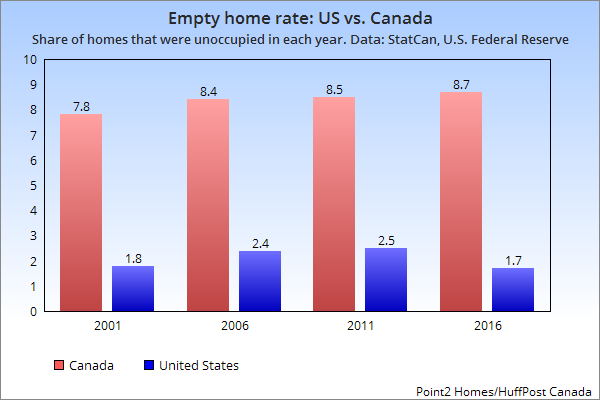
There’s no doubt Canada’s housing supply ― at least in many places ― is very tight. Apartment vacancy rates are near historic lows, and the country’s home ownership rate is shrinking.
But somehow, there is a growing number of empty homes to be found.
Many of Canada’s largest cities have seen a spike in empty home rates in recent years, according to new research from Point2 Homes that shows the issue is a much larger phenomenon in Canada than in the U.S.
The issue of vacant homes has become a hot-button political issue, particularly in pricey cities like Toronto and Vancouver, where policymakers are looking for solutions to a persistent affordability crisis.
Watch: Empty Vancouver mansions make for sweet student crash pads. Story continues below.
Among Canada’s larger cities, Winnipeg saw the largest increase in vacant homes, up 42.7 per cent between 2006 and 2016, according to the census data analyzed for the study. But even with that jump, its home vacancy rate of 4.5 per cent is well below the national average.
Montreal saw a 36.3-per-cent increase in vacant homes in that time, and at 7.6 per cent, its empty-homes rate is higher than Toronto’s. The number of vacant homes increased by 9.6 per cent in Vancouver, and its empty-homes rate rose to 8.2 per cent.
In all, there were 1.34 million empty and temporarily occupied housing units in Canada in 2016, Point2 Homes estimated. The national vacancy rate rose to 8.7 per cent, from 7.8 per cent in 2001.

In some of the Prairie cities, overbuilding and the oil industry slump are to blame for a spike in empty homes, suggested Andra Hopulele, the report’s author.
At 16.5 per cent, Fort McMurray, the oilsands capital, has highest rate of empty homes in Canada, outside of “cottage country” communities near Toronto, where many homes are used seasonally.
Notably, though the number of vacant homes rose in Toronto and Ottawa, they shrank as a share of the total housing market. The vacant home rate is 5.6 per cent in both cities, well below the national average.
These areas have seen very rapid population growth that has convinced some owners who had left their condos empty to rent them out instead, Hopulele suggested.
The pace of new home construction was faster than the growth in empty homes, and that ― coupled with strong demand ― “have kept in check the percentage of vacant homes,” she said in an email to HuffPost Canada.
In fact, the lowest empty home rates in the country were to be found in the Toronto-area communities of Burlington (1.6 per cent) and Ajax (1.5 per cent).
“We estimate that the vacant homes left were mostly the ones ‘abandoned’ by people moving closer to the city center and … newly built condos purchased by foreign investors,” Hopulele said.
“Overall, changes in population numbers, migration of the population towards neighbouring cities, where home prices are lower, economic development or slowdown, overbuilding, speculation, short-term rentals – all these factors have an impact on the number of vacant homes.”
“Seniors ... were not necessarily forced to sell their home, but rather (were able to) leave it empty or keep it for children.”
- Andra Hopulele, Point2 Homes
Vancouver last year instituted an empty homes tax that charges one per cent of a home’s assessed value for every year, or majority part of a year, that it’s unoccupied. The city said earlier this year the tax led to a 15-per-cent decline in the number of empty homes, half of which it estimates ended up on the rental market.
But critics point to data showing the tax only slightly increased the city’s vacancy rate, while bringing in millions in revenue to city coffers. Some politicians have proposed the idea for Toronto as well, but Mayor John Tory appears opposed to it.
Much higher empty home rate than U.S.
Nationwide, 8.7 per cent of all homes were vacant in 2016, the data shows. That rate is five times higher than the U.S., where 1.7 per cent of homes are vacant.
“One issue is that the Canadian government didn’t really monitor the vacant home situation,” Hopulele said. “Before 2001, Canadians had no exact data as to what was happening in the country in terms of vacant homes, to make corrections where and when they were needed.”

U.S. authorities, meanwhile, have been monitoring empty homes since the 1950s, and have been able to react to changing conditions, Hopulele said.
Another potential explanation is that aging Canadian baby boomers have been better off financially than their U.S. counterparts in recent years, and have been able to hold on to real estate they would otherwise have had to sell.
“They did not feel an urgent need to sell their property even if they had to move. Seniors moving to care facilities or closer to downtown were not necessarily forced to sell their home, but rather (were able to) leave it empty or keep it for children,” Hopulele wrote.
Which may suggest that the best way for a would-be homebuyer to get their hands on one of these vacant homes … might just be to inherit it.